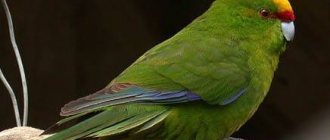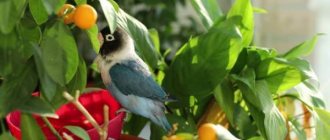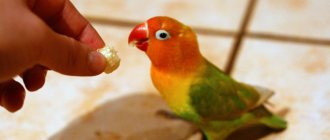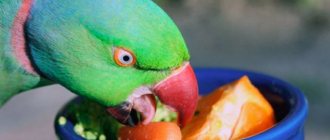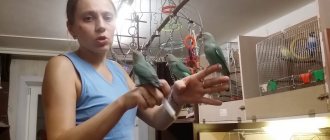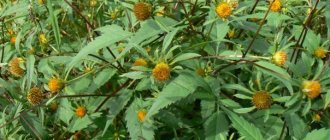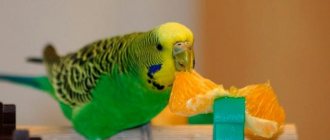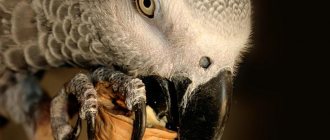The diet of domesticated birds should be varied. In addition to grain food, your pet needs supplements in the form of vegetables and fruits, in the form of bananas, pears, grapes and others. They provide the animal’s body with vitamins and minerals. Let's find out whether the parrot can eat apples.
Can parrots have apples?
Apples are an extremely healthy product, so these fruits must be included in the bird’s diet. They contain:
- fiber and pectin, necessary for the proper functioning of the gastrointestinal tract;
- carbohydrates, which are a source of energy;
- vitamins – C, PP, K, E, B1, B2, B5, B6 and others;
- macroelements – potassium, sodium, calcium, magnesium, phosphorus;
- trace elements - iron, cobalt, copper, molybdenum, chromium, silicon, manganese, zinc, iodine and others.
All these components are necessary to maintain the health of the parrot. Birds that are regularly fed with fruit have a neat appearance, beautiful plumage, are always cheerful and attentive, and learn well.
However, not all apples can be given to a parrot. Store-bought fruits often contain substances harmful to birds, so it is advisable to feed your pets fruits that you grow yourself.
Benefits of fruit for birds
Fiber and natural acids help normalize processes in the gastrointestinal tract. Apples work equally well against both constipation and diarrhea. In the first case, the fibers cleanse the intestines, and in the second, they absorb excess fluid.
Tannins, coupled with acids, prevent the development of fermentation and decay processes in the gastrointestinal tract , and also help with bloating. The low calorie content of the product helps combat obesity, which is not uncommon for domesticated birds. And carbohydrates will replenish lost energy during the molting period and after illness.
The fruit is rich in vitamins C. The elements strengthen the animal’s immunity and have a beneficial effect on the cardiovascular system. The minerals contained in apples remove toxins from the liver, which is especially important for birds living in apartments in large cities.
Green fruits are less tasty than red ones, but they contain much more valuable substances for birds. Therefore, when choosing apples, it is more practical to give preference to the first ones.
Do budgies like apples?
Many novice bird breeders are interested in whether budgies can eat apples and in what quantity. These fruits contain a lot of useful substances that have a beneficial effect on the body of all types of parrots, including budgies. They have aromatic, tasty and at the same time crispy and dense flesh, which is why parrots usually like them very much. In nature, birds willingly eat ripe and juicy tree fruits; Apples are a good alternative to the natural diet in captivity.
Parrots prefer to eat sweet fruits; If given a choice, the bird may refuse sour fruits. However, sweet foods contain a lot of sugars, the excess of which is harmful to the health of parrots. Therefore, budgies should be given apples in moderation; they should not become the basis of the diet.
Is there any harm
If a parrot has stomach problems, such as high acidity, then apples should be abandoned in favor of fruits with a more gentle composition: bananas, peaches, plums, etc. The fruits should also not be given to immature young animals who have not yet begun to eat on their own.
It is better to refrain from treating your pet with apple seeds . The seeds contain amygdalin glycoside, which releases toxic substances when processed. They will not cause harm to the body of adults and large individuals, such as cockatoos, macaws or African grays, but small birds - lovebirds or budgerigars - can be poisoned.
Some parrots cannot tolerate certain elements in principle, which is expressed by allergic reactions of various kinds. Therefore, before including apples in the diet, it makes sense to give your pet a small piece to try.
The fruit selection procedure deserves special mention. It often happens that a beautiful-looking and tasty fruit turns out to be a carrier of dangerous substances. And if the human stomach has more or less adapted to pesticides and other chemicals, then the gastrointestinal tract of a bird can cause serious problems, and in difficult cases lead to death.
Key points when choosing apples:
- presence of damage;
- elasticity;
- color;
- size;
- smell.
There should be no dents or dark spots on the surface. If, when you press on the peel, it bends easily, then most likely the apple is not fresh. Too bright colors should immediately alert you. Good fruits have a uniform and non-flashy color.
Better to give up the giants. Large sizes are largely the result of chemicals, not agricultural technology . The best option is a medium-sized apple. The fruits must emit a characteristic aroma for the crop. The abundance of chemicals partially neutralizes the smell, so its absence is a bad sign.
Some people are afraid of radionuclides in apples and GMOs. In fact, these are unfounded fears. Radionuclides accumulate only in the soil, and apples grow on trees. Given the existing varietal diversity, improving apples at the genetic level is simply unprofitable. It is more practical to carry out another selection.
Why can't you give too many apples?
Fruits contain large amounts of sugars. With excessive consumption of sweet foods, your parrot may develop metabolic disorders, as well as diabetes. In addition, these fruits contain a lot of acids. When they enter the digestive system, they irritate the gastrointestinal mucosa, which causes inflammation. If you overfeed sour fruits, your parrot will develop diarrhea, leading to the loss of a large amount of fluid and preventing the absorption of nutrients from the feed.
On a note! To prevent overfeeding, it is allowed to give small parrots no more than 1/6 part per day, large species - a little more.
Birds' favorite fruit
In the habitats of exotic birds, this culture is found quite often.
Parrots are not averse to eating the fruits of both wild trees and fruits in cultivated plantings on farmland. In terms of availability, demand and cost, apples are the No. 1 fruit in Russia. The culture has more than 7,500 varieties.
The first domesticated apple trees appeared 5,000 years ago on the territory of modern Kazakhstan.
Considering other fruits, the composition of apples can be called unique. The fruits contain about 80% water and about 20% nutrients. Almost everything in apples is useful: pulp, peel and even leaves.
Popular varieties:
- White filling;
- mekintosh;
- Antonovka;
- Jonathan;
- melba;
- Simirenko.
The mentioned varieties are distinguished by good taste and an abundance of elements beneficial to the animal’s body.
In what form should apples be given?
It is best to feed birds fruits grown in your own garden or purchased at the market. Fruits sold in stores contain a lot of nitrates, as well as chemicals used to protect against pests during ripening and storage. In addition, they are often coated with wax to preserve their presentation. Therefore, after purchasing, they must be thoroughly washed and then peeled.
After this, the fruit is inspected and all damaged areas are cut off: darkened impact areas, rotten areas and wormholes. The product is cut into slices, the size of which depends on the size of the bird, or grated. The seeds, stems and core are removed.
The pieces are placed in a feeder or pushed between the bars of the cage. Grated apple can be given pure or mixed with grated carrots; This mixture is extremely rich in vitamins and other beneficial nutrients. Parrots usually like the sweet taste and crunchy texture of vegetables and fruits.
You can give your parrot apples not only fresh, but also dried. Dry slices should be pre-soaked in water for 2-4 hours or boiled until they become soft. Occasionally you can pamper your pet with a treat made from compote.
Green feed
It must be remembered that it is not enough to give birds only grain mixtures; their diet should be supplemented with other ingredients. For example, green food. Fresh greens contain many vitamins, so they are very healthy.
What do budgies like? Birds really like to eat young tree branches; they happily eat buds, bark, and wood. In addition, parrots willingly eat leaves of vegetable plants, the so-called “tops” - young leaves of carrots, radishes, and lettuce. In summer there is no shortage of leaves and herbs. To know what grass budgies eat, you need to carefully read and memorize the list below.
In the summer you can pick the following plants: dandelion, clover, chickweed, bluegrass, fireweed, shepherd's purse, wheatgrass, plantain, nasturtium, timothy, strawberry leaves. Plants should be plucked away from roads and busy highways, and pets should be avoided. It is best to collect plants outside the city limits.
But it should be remembered that not all plants are useful for parrots, and some are even dangerous. Fans of feathered pets should remember well what is prohibited for budgies.
Some indoor plants are very dangerous for these birds; parrots can become poisoned if they eat them. Among these plants are amaryllis, hyacinth, azalea, hydrangea, periwinkle, dieffenbachia, cocoa tree, caladium, jasmine, narcissus, cana, bracken fern, nightshade, colocasia, poinsettia, crocus, laurel, ranunculaceae, oleander, ivy, philodendron, aeonium and etc.
Poisonous flowers: tulip, narcissus, poppy, peony, etc. Poisonous wild plants: buckthorn, white acacia, oak, burdock, juniper, horse chestnut, elderberry, etc.
Twig food is perfect for vitamin feeding in winter. Tree branches also help clean the parrot's beak.
The following branches are excellent for branch food: - Birch, - Linden, - Currant, - Cherry, - Apple, - Raspberry.
Among the trees there are also poisonous for small pets: lilac, bird cherry, coniferous trees, pear.
Vegetable menu
Fresh vegetables are an integral part of a budgie's diet. Give what you need every day.
Let us explain what vegetables can be given to a budgie:
- cabbage - white cabbage, broccoli, Peking cabbage and other types of this family. Everything contains a lot of all kinds of useful components. It is beneficial for the stomach when consumed, stimulates metabolism and easily cleanses the body of waste and toxins;
- carrots – the root vegetable contains carotene, lysine, ascorbic and pantothenic acid. Promotes pet growth and good vision. One piece a day is enough;
- pumpkin - in addition to its aesthetic qualities, has many useful components. The pulp is saturated with all kinds of vitamins, magnesium, potassium, iron. Removes toxins and excess cholesterol;
- cucumber – a huge content of vitamin E. A rich community of minerals. Helps in the absorption of food and normalize metabolism;
- beets - occupies a leading position in the presence of useful components. It has antioxidants and many other useful minerals necessary for the life of a budgie. Provides a wide range of benefits to improve the functioning of the body.
- Tomato or tomato has obvious benefits for your pet; it is a powerful antioxidant. Is a source for the health of the parrot. Normalizes metabolism, prevents the appearance of fungal diseases.
What should you do if your parrot accidentally swallows an apple seed?
While apple seeds may not always have an adverse effect on your parrot, it is important to keep a close eye on them if they accidentally ingest them.
Signs that the seed may be causing illness may include loss or increase in appetite, closed eyes, limited mobility, shortness of breath, increased thirst, isolation, weight loss and diarrhea.
If you notice any of these symptoms, take your pet to the vet immediately.
If you are very concerned about your parrot or if he has eaten several seeds, do not wait for a reaction or symptoms to appear. Take them to the vet immediately after ingestion and explain the situation. Again, better safe than sorry.
Berry expanse
If you ask yourself whether parrots can eat berries and what kind, the answer will be: almost everything. In summer, the following are ideal ways to diversify the bird menu:
- Watermelon has a laxative effect. chokeberry (chokeberry),
- hawthorn,
- cowberry,
- cherry,
- blackberry,
- strawberries,
- strawberry,
- gooseberry,
- raspberries,
- sea buckthorn,
- Rowan,
- currant,
- blueberry,
- rose hip.
The restrictions apply only to viburnum, which should not be given to feathered pets with kidney problems.
In winter, you can also give the wavy birds a berry treat if you prepare the berries for future use by freezing or drying. Frozen fruits should be completely defrosted before serving, and dry fruits should be steamed or soaked in hot water.
The largest berry is watermelon. Like other melons, it is extremely nutritious, but as for the bird menu, there is a caveat: it is not recommended to give it to your pets a lot, since it has a laxative effect.
Eat it, ass, don't be ashamed! How to train a budgie to eat fruit?
There are often cases when budgies seem to refuse fruits/berries without any reason. This happens because resellers at markets or employees of pet stores, in order to reduce the cost of maintaining “feathered goods,” feed the birds with inexpensive dry grain mixtures. The parrots get used to this food, and then it is very difficult for them to switch to an updated diet: the birds are simply afraid.
How to teach them to eat fruit? We'll have to experiment. To begin with, you should offer your pet fruits in different “forms”: cutting them into slices, rubbing them into a puree, cutting them into larger pieces, or even squeezing the juice.
The bird's digestive system absorbs the juice very easily, and this will help the parrot taste the fruit itself over time. You can start with apple juice.


